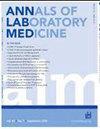基于SLC25A13致病变异综合分析的东亚和韩国人柠檬素缺乏的携带者频率和流行程度
IF 3.9
2区 医学
Q1 MEDICAL LABORATORY TECHNOLOGY
引用次数: 0
摘要
citrin缺乏症是一种常染色体隐性遗传病,由SLC25A13的致病变异引起,表现为各种年龄依赖性临床表型和广泛的严重程度。然而,很少有研究调查了柠檬酸缺乏症的频率和流行程度。我们的目的是分析东亚人群和韩国人群的携带者频率和疾病流行情况。方法综合文献,采用横断面研究方法,分析基因组数据库(Genome Aggregation Database, gnomAD)、韩国变异档案(Korean Variant Archive, KOVA)和东北医学大库组织(Tohoku Medical Megabank Organization, ToMMo),以确定东亚人群中致病的SLC25A13变异。利用681名韩国人的全基因组测序数据,用Linux grep命令研究了SLC25A13内含子16上的一个3千碱基(kb)插入。结果共检出23个SLC25A13致病变异,其中以c.852_855del最为常见。对gnomAD和ToMMo数据库中17,501名东亚人的数据分析显示,62人中有1人携带这种基因。对gnomAD和KOVA数据库中7,214人的数据进行分析后发现,携带者频率为1 / 86,相当于估计疾病患病率为1 / 29,502。c.1177+1G>A是韩国人中最常见的致病变异。681个个体中有3个检测到内含子16的3kb插入,表明载体频率为1 / 228。结论东亚人群柠檬酸缺乏症的高携带频率突出了加强遗传筛查和咨询的必要性,特别是在韩国,为进一步研究该人群的遗传多样性和致病变异提供了有价值的参考。本文章由计算机程序翻译,如有差异,请以英文原文为准。
Carrier Frequency and Prevalence of Citrin Deficiency in East Asians and Koreans Based on Comprehensive Analysis of Pathogenic SLC25A13 Variants.
Background
Citrin deficiency is an autosomal recessive disorder caused by pathogenic variants in SLC25A13, presenting with various age-dependent clinical phenotypes and a broad spectrum of severity. However, few studies have examined the frequency and prevalence of citrin deficiency. We aimed to analyze the carrier frequency and disease prevalence in East Asian populations and Koreans.
Methods
We comprehensively reviewed the literature and conducted a cross-sectional study to analyze genomic databases, including the Genome Aggregation Database (gnomAD), Korean Variant Archive (KOVA), and Tohoku Medical Megabank Organization (ToMMo), to identify pathogenic SLC25A13 variants in East Asian populations. A founder 3-kilobase (kb) insertion in intron 16 of SLC25A13 was investigated using whole-genome sequencing data from 681 Koreans with the Linux grep command.
Results
Twenty-three pathogenic SLC25A13 variants were identified, with c.852_855del being the most common. Analysis of data from 17,501 East Asian individuals in the gnomAD and ToMMo databases revealed a carrier frequency of 1 in 62 people. Analysis of data from 7,214 individuals in the gnomAD and KOVA databases revealed a carrier frequency of 1 in 86, corresponding to an estimated disease prevalence of 1 in 29,502. c.1177+1G>A was identified as the most prevalent pathogenic variant in Koreans. The 3 kb insertion in intron 16 was detected in three out of 681 individuals, indicating a carrier frequency of 1 in 228.
Conclusions
The high carrier frequency of citrin deficiency in East Asians highlights the need for enhanced genetic screening and counseling, particularly in Korea, providing a valuable reference for future studies on genetic diversity and pathogenic variants in this population.
求助全文
通过发布文献求助,成功后即可免费获取论文全文。
去求助
来源期刊

Annals of Laboratory Medicine
MEDICAL LABORATORY TECHNOLOGY-
CiteScore
8.30
自引率
12.20%
发文量
100
审稿时长
6-12 weeks
期刊介绍:
Annals of Laboratory Medicine is the official journal of Korean Society for Laboratory Medicine. The journal title has been recently changed from the Korean Journal of Laboratory Medicine (ISSN, 1598-6535) from the January issue of 2012. The JCR 2017 Impact factor of Ann Lab Med was 1.916.
 求助内容:
求助内容: 应助结果提醒方式:
应助结果提醒方式:


